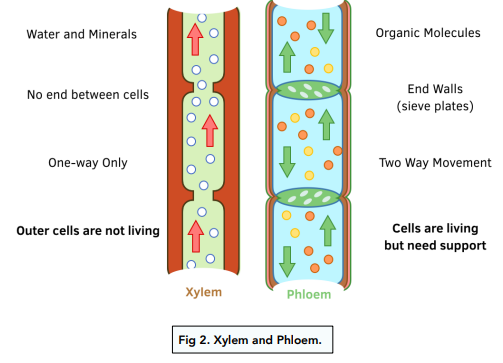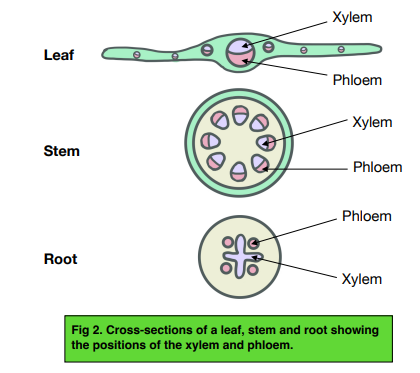Transport in Plants - Transport Systems in Plants (GCSE Biology)
Transport Systems in Plants
Transport Systems
- Plants have a a transport system. Water, food and ions are transported by the xylem and phloem in a plant.
- The xylem transfers water and mineral ions. The xylem is a vascular bundle that transports water and ions to the leaf. This occurs through the process of transpiration.
- The phloem transfers food. The phloem moves glucose and amino acids away from the leaf. This occurs through the process of translocation.

Xylem and Phloem Positions
You can identify the xylem and phloem from cross-sections of different parts of a plant as they are always found in the same places in a stem, root or leaf in flowering plants:
- In leaves, the xylem and phloem form the veins.
- In stems, the xylem and phloem are towards the outside.
- In roots, the xylem is in the middle surrounded by the phloem.

Translocation
Translocation is the movement of glucose/ sucrose and amino acids from sources to sinks through the phloem.
- Source is where the food molecule is made. This is where you will find a high concentration of the food molecule. Various parts of a plant can be sources e.g. leaves, flowers and roots at times.
- Sink is where the food molecules are stored and/ or used up. As they are used up, there will be lower concentrations of the food molecules at the sinks. Sinks can also be at various parts of the plants
e.g. roots and bulbs where respiration takes place. - A part of a plant can be both a source and a sink. Depending on the growth status of the plant, sources can be sinks e.g. when a new leaf grows, it starts as a sink but after maturing, it can become a source.
Transport in plants refers to the movement of water, minerals, and other substances throughout the plant. This process is necessary for the plant to maintain its growth and health.
Plants transport water and minerals through their roots and up into their stems and leaves using a process called transpiration. Water is drawn up the plant by a process called osmosis and then transported through tubes in the plant called xylem. Minerals are also transported up the plant through the xylem.
Transpiration is the process by which water is drawn up the plant and then lost through small pores in the leaves called stomata. This process helps to draw water and minerals up the plant, as well as cool the plant down.
The xylem is a system of tubes in the plant that transport water and minerals from the roots to the leaves. The xylem is essential for the plant to maintain its growth and health, as it provides the plant with the necessary resources for photosynthesis and growth.
The phloem is a system of tubes in the plant that transport sugars and other organic compounds from the leaves to other parts of the plant, such as the roots or fruit. The phloem helps to distribute the energy produced by photosynthesis throughout the plant.
The xylem transports water and minerals from the roots to the leaves, while the phloem transports sugars and other organic compounds from the leaves to other parts of the plant. Both systems are essential for the plant to maintain its growth and health.
No, plants cannot survive without their transport systems. The xylem and phloem are essential for the plant to transport water, minerals, and organic compounds throughout the plant. Without these transport systems, the plant would not be able to grow and maintain its health.






Still got a question? Leave a comment
Leave a comment